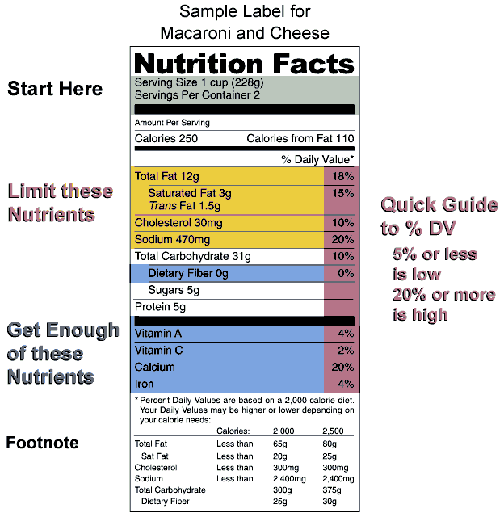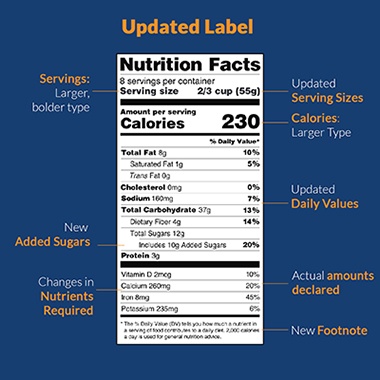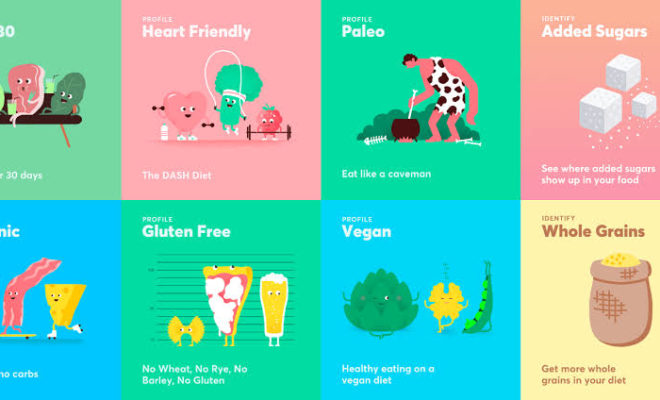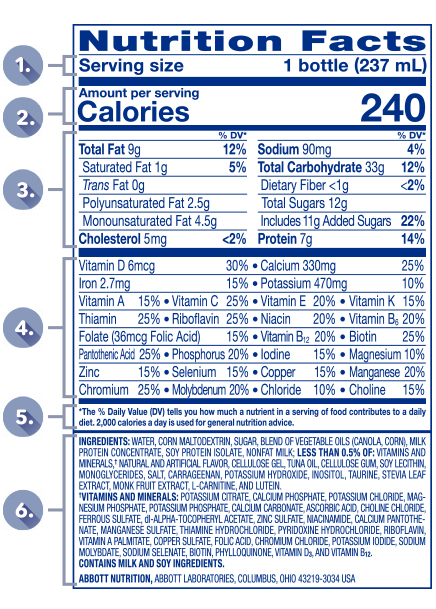42 understanding nutritional facts on labels
Learn How the Nutrition Facts Label Can Help You Improve Your Health Nutrients Required on Label Vitamin D and potassium values are required. Calcium and iron will continue to be required. Vitamins A and C will no longer be required but can be included on a voluntary basis. Slight Decrease in Sodium Allowance The daily limit for sodium decreased slightly from 2,400 mg per day to 2,300 mg per day. The Basics of the Nutrition Facts Label The following is a quick guide to reading the Nutrition Facts label. Step 1: Start with the Serving Size Look here for both the serving size (the amount people typically eat at one time) and the number of servings in the package. Compare your portion size (the amount you actually eat) to the serving size listed on the panel.
How To Read Food and Beverage Labels - National Institute on Aging At the top of the Nutrition Facts label, you will find the total number of servings in the container and the food or beverage's serving size. The serving size on the label is based on the amount of food that people may typically eat at one time and is not a recommendation of how much to eat. Read more about serving and portion sizes.
Understanding nutritional facts on labels
Understanding Nutrition Labels and Nutrition Facts The Nutrition Facts label is a tool that consumers can use to help make food choices that are best for their individual health. However, it can be a bit confusing, especially when it comes to added sugars in foods until the new FDA-required nutrition facts labels fully go into effect. Serving Size Percent Daily Value (%DV) Sugar Understanding Nutrition Labels and Information On the nutrition facts label, total fat includes the amount of saturated and trans fat listed. Total fat also will be represented in calories listed as "calories from fat". Try to choose items that do not have more than 30 percent of their calories from fat, which can be calculated by dividing "calories from fat" by "calories." PDF Understanding the Nutrition Facts Label number of calories and other nutrients from what is on the label, so it is important to be aware of that. "CALORIES COUNT" The calorie count written is PER SERVING. Along side the calories per serving is the number of calories that come from fat. As a general rule, look for foods that contain less than 20% of its calories from fat.
Understanding nutritional facts on labels. How to Understand and Use the Nutrition Facts Label | FDA Dietary fiber, vitamin D, calcium, iron ad potassium are nutrients on the label that Americans generally do not get the recommended amount of. They are identified as nutrients to get more of.... How to Read Nutrition Facts Label - Food Network The American Heart Association recommends no more than 100 calories from added sugar per day (about 6 teaspoons or 24 grams of sugar) for most women and no more than 150 calories per day (about 9 ... Understanding Nutritional Labels - Beaumont Health So remember that when doing your math. Here are the parts of most food labels: Calories (total calories and calories from fat) - This part of the label tells you how many calories each serving has and how many of those calories come from fat. Total Fat - Total fat is the number of fat grams per serving. There are different types of fat. PDF How Do I Understand the "Nutrition Facts" Label? your total calories. For a person who needs 2,000 calories a day, this is 120 calories or less, or about 13 grams of saturated fat. Most foods in the grocery store have a Nutrition Facts label and ingredient list. When you go grocery shopping, take time to read the Nutrition Facts labels on the foods you purchase. Compare the nutrients and
Get the Facts! Steps to Reading and Understanding Nutrition Facts Labels Check out the % Daily Value. Food labels list percentages of the recommended daily intakes of several nutrients. The numbers are based on a 2,000-calorie diet and are used for adults who are 18 years or older. If you consume more or less than 2,000 calories per day, you still can use % Daily Values as a reference. Understanding Food Labels | The Nutrition Source | Harvard T.H. Chan ... The Nutrition Facts Label The Nutrition Facts label is overseen by the U.S. Food and Drug Administration (FDA) and was first mandated under the Nutrition Labeling and Education Act of 1990 to help consumers make quick, informed food choices. It has undergone revisions, with the latest update released in 2016. Food Labels 101: Understanding the Nutrition Facts Label A sodium level of 140 mg or less on the nutrition facts label is considered low sodium. This is an essential number to look for when reading the label. Total Carbohydrates - Fiber and Sugar Foods high in fiber can be beneficial to a healthy diet, as fiber helps manage blood sugar levels and can lower cholesterol. How to understand food nutrition labels | by Alpha Medical Team | Alpha ... The FDA says a food that has 5% daily value or less of a particular nutrient is considered low in that nutrient. One with 20% or more is high. One thing to note about daily values is that the ...
Help patients understand Nutrition Facts labels to eat smarter This video provides a general overview of the four key sections of the Nutrition Facts label: servings, calories, percent Daily Value and nutrients. The video offers practical guidance for patients on how to use the Nutrition Facts label to compare packaged foods and beverages and make informed dietary choices. Reading Nutrition Facts Labels - University of Arizona Nutritional labels provide a wealth of important information about the foods we consume. Based on the nutritional label you can make decisions about what foods are best for you. ... It's important to understand the steps involved in reading a nutritional label. Check the serving size and calories: Begin by looking at the serving size and the ... Understanding the Nutrition Facts Label - Know Diabetes by Heart No label! You can look up the nutrition information via Google or a food application and determine it has about 20 grams of carbs. Adding the two together equals 57. Now let's say your insulin to carb ratio is 15. You would divide 57 by 15 to get 3.8 units (rounding to 4 units of insulin for that meal). Nutrients Understanding Food Nutrition Labels | American Heart Association When the Nutrition Facts label says a food contains "0 g" of trans fat, but includes "partially hydrogenated oil" in the ingredient list, it means the food contains some trans fat, but less than 0.5 grams per serving. So, if you eat more than one serving, you could end up eating too much trans fat.
Understanding Ingredients on Food Labels - Professional Heart Daily Understanding Ingredients on Food Labels. Food labels are an important source of information about calories and the nutritional value of the foods you eat, a crucial tool in building a heart-healthy diet. The Nutrition Facts information is always displayed in the same orderly fashion and helps you understand how much of certain nutrients that ...
Nutrition Facts: How to Read Nutrition Labels - Greatist The nutrition label lists total fat, saturated fat, and trans fat. It's the last two you want to focus on. Saturated fat is the kind you'll find in a burger, hot dog, or glass of whole milk. Eating...
Food Labels | CDC If you eat the whole thing, you are eating 8 times the amount of calories, carbs, fat, etc., shown on the label. Total Carbohydrate shows you types of carbs in the food, including sugar and fiber. Choose foods with more fiber, vitamins, and minerals. Choose foods with lower calories, saturated fat, sodium, and added sugars. Avoid trans fat.

Here's What To Look For On A Nutrition Label #NutritionLabel | Nutrition facts, Nutrition labels ...
2.5 Understanding Food Labels - Introduction to Nutrition and Wellness The value printed on the Nutrition Facts panel is the percent DV, which tells you how much one serving of the food contributes towards meeting the daily requirement for that nutrient. The FDA uses the following definitions for interpreting the %DV on food labels:4. 5%DV or less means the food is low in a nutrient.
Food labels 101: Understanding the nutrition facts panel Calories - This is below the serving information. The label tells you the amount of calories per serving and also how many calories come from fat in the food. Calories are the energy that a person gets from consuming the food. Most people eat more calories than needed, yet do not get enough of the nutrients their body needs.
Food Labeling 101: Understanding the Nutrition Facts Label Ingredients are listed in order of amount by weight, starting with the largest amounts. This can be the most important information if there are ingredients you're avoiding for one reason or...
Reading and Understanding Food Labels and Nutrition Info | Beaumont Health A one-percent reduction of saturated fat in your diet reduces your heart disease risk by three percent. Keep saturated fat to less then 15 grams per day. It is not required to list unsaturated fats (polyunsaturated and monounsaturated) on food labels. In general, unsaturated fats lower cholesterol. The healthiest unsaturated fat is canola oil.
Reading and understanding the Nutrition Facts Label for health The Nutrition Facts Label is making changes that will be required by all manufacturers by Jan. 1, 2020; however, the majority of labels already adhere to these changes. Nutrition Facts Labels include nutrients we should limit such as fat, saturated fat, trans fats, cholesterol, sodium and added sugar. They also list nutrients important to ...
Understanding and Using the Nutrition Facts Label - FDA The Nutrition Facts label can help you learn about, compare, and monitor the nutrients in many foods in your family's diet. 4 % Daily Value (%DV) shows how much of a nutrient in a serving of the...
Understanding a Nutritional Facts label for new Product Development The nutritional information label also provides a column of values called per cent % Daily Value (% DV). It denotes how much of a nutrient is present in one serving of food which needs to be consumed one day. This value is based on an average daily diet of 2000 calories.
How to Read Nutrition Facts Labels the Right Way - GoodRx Nutrition Facts labels are required to list the total fat, saturated fat, and trans fats on packaged food products. It's important to choose foods with the right kinds of fats. Here are the differences between the fats you'll see on the label. Bad fats Saturated and trans fats are the less healthy types of fats.
PDF Understanding the Nutrition Facts Label number of calories and other nutrients from what is on the label, so it is important to be aware of that. "CALORIES COUNT" The calorie count written is PER SERVING. Along side the calories per serving is the number of calories that come from fat. As a general rule, look for foods that contain less than 20% of its calories from fat.
Understanding Nutrition Labels and Information On the nutrition facts label, total fat includes the amount of saturated and trans fat listed. Total fat also will be represented in calories listed as "calories from fat". Try to choose items that do not have more than 30 percent of their calories from fat, which can be calculated by dividing "calories from fat" by "calories."
Understanding Nutrition Labels and Nutrition Facts The Nutrition Facts label is a tool that consumers can use to help make food choices that are best for their individual health. However, it can be a bit confusing, especially when it comes to added sugars in foods until the new FDA-required nutrition facts labels fully go into effect. Serving Size Percent Daily Value (%DV) Sugar










Post a Comment for "42 understanding nutritional facts on labels"